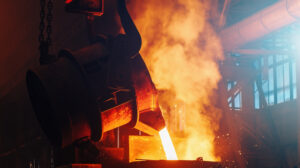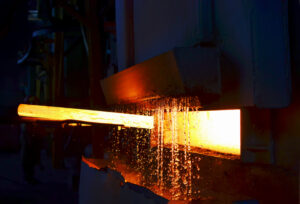From material selection to testing, metallurgy touches every aspect of your metal part design. But still, many part designers overlook the ongoing importance a metallurgist plays in the foundry production process.
Part designers may understand the need for the metallurgical research that goes into selecting the materials, but not that the significance of the science goes beyond that. It takes exploring the foundry life cycle of a typical metal part to get a further understanding.
It’s a journey we think offers the best understanding of why a metallurgist is critical in getting you better results for your design.
Metallurgy in the foundry life cycle
Most foundries would agree that a metallurgist should be involved in just about every aspect of part manufacturing. But for some foundries, the only way to offer that is to outsource their metallurgical requirements, weakening their connection to the science and creating additional costs.
But for those foundries with an onsite metallurgical team, the contribution starts right away by providing critical input in the following areas:
- Design stage
- Materials selection
- Manufacturing phase
- Secondary processes
- Testing requirements
And often, the metallurgist is involved before any design or production even begins.
“The sales team regularly reaches out to us even before an order has been made to ensure we have the material a customer is requesting,” says Andy Ruble, Metallurgist at Spuncast Centrifugal Foundry.
“There’s a lot of different steel grades that can come up in an RFQ (request for quote), but with a metallurgical team onsite like ours, there’s not many we can’t make.”
Ruble says another benefit is that the customer’s budget can be considered from the get-go, and the team can suggest the appropriate compromises in material and manufacturing if required.
“That doesn’t mean their material will be low quality,” he said. “It just means when we know more about the project, we often can adjust the metal and keep what’s important to meet their performance requirements.”
It’s an expertise that can save a part designer significantly on material costs.
Design stage: Asking the key questions
In the design of any metal component, it is necessary to understand and address key questions like how the part will be used and if there are any process requirements.
Understanding the relative importance of each question influences the manufacturing process and gives a good idea of how it applies to the end product.
A metallurgist will be the most qualified to consider the answers to those questions when planning your part’s execution.

The metallurgist will also take into account the foundry’s experience and setup. Therefore, requirements for further foundry expertise, like secondary processes, will be included in production.
Material selection: The balancing act between chemical and physical properties
The quality of your part determines the longevity of your end product. And the quality depends mainly on balancing the chemical and physical properties of the material used.
- The chemical properties involve how the material reacts with other elements.
- The physical properties include such things as tensile, yield, elongation, hardness, density, freezing and boiling points, and electrical properties.
Metallurgical concepts such as alloy design and microstructural engineering help link processing and performance to the properties of metals. Through these efforts, the material chosen for the parts or components being manufactured is produced with the application in mind.
Material requests like, for example, a longer product life cycle are much easier to obtain when a metallurgist is involved. And it also means you can specify the base material to meet your design’s specifications using metallurgical customization.

For Ruble and his team, metallurgical customization requests occur fairly often. He says a common one is for an interpretation of material specifications used in a forged product to one that works for a cast product.
“We are able to stay within the ASTM standards required,” he said. “It’s something that consistently saves the customer money on material because it allows them to go from a solid tube to a hollow one that requires less metal.”
Manufacturing process: Setting up a stable production environment
Because metallurgical defects can still occur in a metal part during the manufacturing process, getting the execution right is key.
A metallurgist is often used to set up a stable production environment for any specific metal part. Considerations around temperature, speed, and time during manufacturing are crucial.
For centrifugal casting, in particular, Greg Whitman, Vice President of Sales and Engineering for Spuncast, says, “A metallurgist’s participation enhances the design, material selection, and the capability of a manufacturing process to achieve the best possible outcome.”

An experienced centrifugal casting foundry with an onsite metallurgist is known for consistently manufacturing parts without any mid-wall defects. The results are parts free of shrinkage cavities, gas pockets, and blowholes.
Secondary processes: Deciding on the appropriate treatment
An experienced metallurgist can help you decide on the most appropriate secondary treatments for your metal.
The most often used methods include heat treatments like quenching and tempering, annealing, normalizing, and stress relief.
To further manipulate the material, they may suggest:
- Increasing or decreasing the temperature
- Controlling the pace and timing of the applied heat
- Speeding up or slowing down cooling
Because how metal is treated impacts the end product, often the processes involve several rounds of any or all of these suggestions.
An experienced, modern foundry will offer a variety of in-house heat treatments supervised by material specialists.
In-house secondary treatments can also maximize cost efficiency. Because sending your part to another facility takes time and money, using a foundry with full in-house capabilities will save you both. You’ll also be working with experts who know your project from the start.
Metal testing: The key to steering clear of defective parts
Metal testing can be used to determine the material’s mechanical characteristics, such as strength, hardness, tensile, yield, and elongation.
Other tests evaluate chemical characteristics like composition or residue analysis or corrosion resistance for conditions like humidity or salt water.

Ruble says getting the “recipe” for your alloy right is especially important in manufacturing metal parts. That’s because the wrong material can result in defective critical components.
The example he gives involves metal used in manufacturing a specific part designed for outdoor use. If it is not alloyed with the right metal for the application, the parts won’t have the needed corrosion resistance.
He explains that because there are thousands of different alloys, they all must be composed of only the specific metals designed for that particular component. Even minor differences can be catastrophic if they lack the appropriate elements or contain a different composition of elements.
That’s why metallurgical testing and verification should be done throughout the manufacturing process. The structural integrity of any part or component depends on it. And in the end, you should have a material test report (MTR) that verifies the results.
It’s testing that typically includes:
- ASTM and/or ASME standards compliance
- Specific size, shape, and/or diameter specifications
- Chemical and physical properties specifications
Knowledge of metallurgy and materials, plus an understanding of the overall need for the material itself, is essential. This is why a qualified material specialist should be the only one to do the test.
The backbone of the foundry
Developing better materials and processes and ensuring they are tested to stand up to the application is the focal point of any metallurgist. But solving everyday metallurgical challenges takes being able to revisit the product’s design, understand its end-use, and work closely with the manufacturing team.
That’s why metallurgy will continue to be the backbone of any experienced foundry. When a metallurgist is included in design and development, the production process and the end result will always be enhanced.
Spuncast’s experienced metallurgical team can help you get the best out of your next part design. We offer in-house metal testing, secondary processes, and modern centrifugal casting – the methodology that consistently delivers steel tubes with strength, purity, and cost-efficiency.

